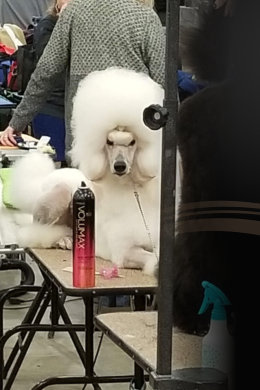






Those Darned Judges...
©David J. Arthur, November, 2012 People always have a reason why their dog didn’t win, and usually it implicates a judge. Regardless of whether in AKC, UKC, ARBA, this KC, that KC, and etc. ad-nauseam, the dissatisfaction ranges from selecting handlers to outright incompetence. While some of it is likely deserved, the truth is, most judges work very hard to identify and place the most deserving dogs. So before beating up a judge, remember that your $25 entry is a ticket into the great forum of learned “opinion”, where you willingly subject yourself to someone else’s interpretation of your breed standard. Thus, if you want big rosettes, then chase down the most favorable judges. If you want the best “opinion”, skip the show, find a trusted breeder, and then chat candidly over a Starbuck’s about the finer points of conformation. No matter how much one studies, there are always tidbits that experienced breeders consider more valuable than the usual all- rounder can see. They do their best, and often get it right. When they get it wrong, we all hear about it. From personal experience, I once returned from a rather nightmarish weekend, only to find my reputation being shoveled into a heap of steaming judgment on the internet. I obviously didn’t meet that person’s lofty expectations, and when it was all said and done, they not only slandered me, but also dug a pit for their own burial. Conversely, I considered a couple of Whippets one afternoon, where one of the handlers had bred both specimens. As the judging continued, we conversed about the breed, whereby I made my selection, and went on with the day. After the show, the exhibitor found me and we resumed the discussion over those finer points that excite Whippet breeders. I learned a lot, making for a wonderful experience. The point is that judges are not sacrosanct messengers from God. By approaching politely, you really do have the opportunity to discuss their evaluations. When that happens, not only may you help a judge, but you also might learn from their insight. Those momentary encounters benefit both judge and exhibitor, thus bettering the sport as a whole. It’s also a good idea to try and view the evaluation process from the judge’s point of view. The UKC follows the concept of “positive judging”, looking for exceptional quality instead of simply counting faults. The dog with the fewest faults is usually the most mediocre, whereas the dog with something spectacular, regardless of faults, might make the greatest contribution to their breed. Unless the standard says “disqualification”, all faults should be evaluated in relation with the whole. Good judges also “look” with their hands. This is particularly important while ringside judging. As a spectator, I always keep in mind that I don’t have my hands where the judge does. Everyone knows that a decent pair of shears, some chalk, and a marker pen can make nearly any dog look perfect. But place your hands on it, and you may well encounter a deeper truth. Movement also betrays what’s beneath the coat. The bones may be in their right places, but if the muscles aren’t, that statuesque demigod may turn into Frankenstein’s monster during the down-n-back. Dogs must be able to perform the function of their breed, and all things being equal, a movement or structural fault should be weighted to a much greater degree than mere cosmetics. None-the-less, even that concept is slave to each standard. Take a dog with a horribly sloped backline, straight rear, oversized head, and that moves like a traffic accident, and overall, you probably have a very nice Neapolitan Mastiff. An Epagneul Breton with a beautifully soft brushed coat or a Shi Tsu with a scissors bite should both be one of the first eliminated. You can’t generalize on what’s right or not, because even though there is commonality, each breed does have its own distinctions according to their standard. Judges must follow these written guidelines, and not just rely on the collective norms such as a floating gait or square structure. Again, unless the evaluator is a tenured breeder, the whole process still boils down to that person’s interpretation of your standard. What may seem rather rangy to you, to the judge’s eye is only “slightly longer”. “Medium” to one person is monstrously huge to the next, and exactly how deep is “moderate”? Even between breeders, and especially between the regions, there is dissention amongst the ranks. And yet, we, as exhibitors, expect that “expert” in the middle of the ring to intuitively know exactly what is correct or incorrect in our own estimation. This also forms a good caution for judges; choose your mentors well, lest you be led down the track of fads and misconceptions. Not all successful breeders are breeding in-line with their standard. More than enough consternation oozes ringside when the discussion turns to which dogs are little more than well- campaigned pets. One must admit it happens, and no dog is perfect. But any judge who does little more than perusing Showsite between assignments is also one who should reconsider their vocation. There really is safety in a multitude of councilors, and verification of what you see in the ring will go a long way toward making you look quite intelligent to the exhibitors who show to you. And as for the “throwaway breeds”, unfamiliarity is no excuse for passing over them in Group. Granted, you may not have the greatest degree of experience with them, but that’s no excuse for not giving the same level of consideration and study as you would to the more popular breeds. Oh, and since I do love a good controversy, who really does have the best judges? While AKC has the more rigorous qualification process, the UKC allows for far more experience. Granted, the UKC should probably have a stronger apprenticeship program. But would going to AKC’s extreme do much better for a judge’s abilities? You either have the eye, or you don’t, and in both registries, those judges who are truly conscientious can usually fish-up the cream from the common. In fact, there are a number of judges who have dual approval, which I personally believe makes for a much better judge. Lastly, let’s not forget about that dreaded disease...kennel blindness! Before dragging some poor judge through the mud, please be honest about your stock in relation to what you’re facing in the ring. It’s always a blessing to hear an honest exhibitor walk away with the phrase, “I don’t mind losing to something that good.” When there are better dogs entered, then you’re probably going to get beat! And you will further your reputation and the direction of your breeding program to honestly acknowledge what you’re exhibiting, and to applaud the judges when they make the right selections...even when it’s not your dog being placed. But what about those times when you do bring the best dog, have it groomed to perfection, and you can clearly see outright politics or ineptitude? Are we not still to be sportsmen? Granted, there are those judges who occasionally...or for some, often...need a good beating! But leave that to those exhibitors who care little for their status. No one can ever fault you for being gracious, while not being so can easily place your show career in jeopardy. Nobody likes a sore loser, even when they’re right. So, lest someone grab you by the nose and drag you to the center of the ring with the admonition for you to decide, please give that poor judge the benefit of the doubt. At least the ones I know and show to regularly have spent years in study, and they really do know which end of the lead has the loop and which has the clip. But most of all, remember... You only paid for an opinion!



















